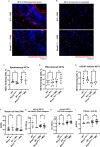The circadian clock gene BMAL1 modulates autoimmunity features in lupus
- PMID: 39664388
- PMCID: PMC11631884
- DOI: 10.3389/fimmu.2024.1465185
The circadian clock gene BMAL1 modulates autoimmunity features in lupus
Abstract
Objectives: An important pathogenic role for neutrophils in systemic lupus erythematosus (SLE) has been proposed. Neutrophils that lack brain and muscle aryl hydrocarbon receptor nuclear translocator-like 1 (Bmal1), one of the clock genes, are defective in aging and proinflammatory responses. We assessed the role of Bmal1 in clinical and immunologic manifestations of murine lupus and in human SLE neutrophils.
Methods: Myeloid-conditional Bmal1 knockout mice (Bmal1Mye-/- ) and wild type (WT) were treated with epicutaneous TLR7/8 agonist (imiquimod; IMQ) for 6 weeks to induce a lupus phenotype. Upon euthanasia, immune responses, autoantibodies and renal manifestations were evaluated. NET formation and gene expression of bone marrow (BM)-derived murine neutrophils were evaluated. BMAL1 expression was quantified in SLE neutrophils and compared with clinical disease.
Results: IMQ-treated Bmal1Mye-/- and WT displayed comparable systemic inflammation. While renal function did not differ, serum anti-dsDNA levels and renal immune complex deposition were significantly increased in Bmal1Mye-/- . While no differences were observed in NET formation, expression levels of April in BM neutrophils were significantly higher in Bmal1Mye-/- . Bulk RNA-sequence data showed that BM neutrophils in IMQ-treated Bmal1Mye-/- were relatively immature when compared with IMQ-treated WT. BM showed an enhanced April protein expression in Bmal1Mye-/- mice. BMAL1 levels in human SLE peripheral blood neutrophils correlated positively with serum C3 and negatively with serum anti-dsDNA levels.
Conclusion: Bmal1 is associated with lower disease activity in SLE. These results indicate that perturbation in the circadian rhythm of neutrophils can have pathogenic consequences in SLE.
Keywords: April; Bmal1; autoantibody; clock gene; neutrophils; systemic lupus erythematosus.
Copyright © 2024 Nakabo, Sandoval-Heglund, Hanata, Brooks, Hoffmann, Zhang, Ambler, Manna, Poncio, Hasni, Islam, Dell’Orso and Kaplan.
Conflict of interest statement
The authors declare that the research was conducted in the absence of any commercial or financial relationships that could be construed as a potential conflict of interest.
Figures






References
MeSH terms
Substances
Grants and funding
LinkOut - more resources
Full Text Sources
Medical
Molecular Biology Databases
Miscellaneous

